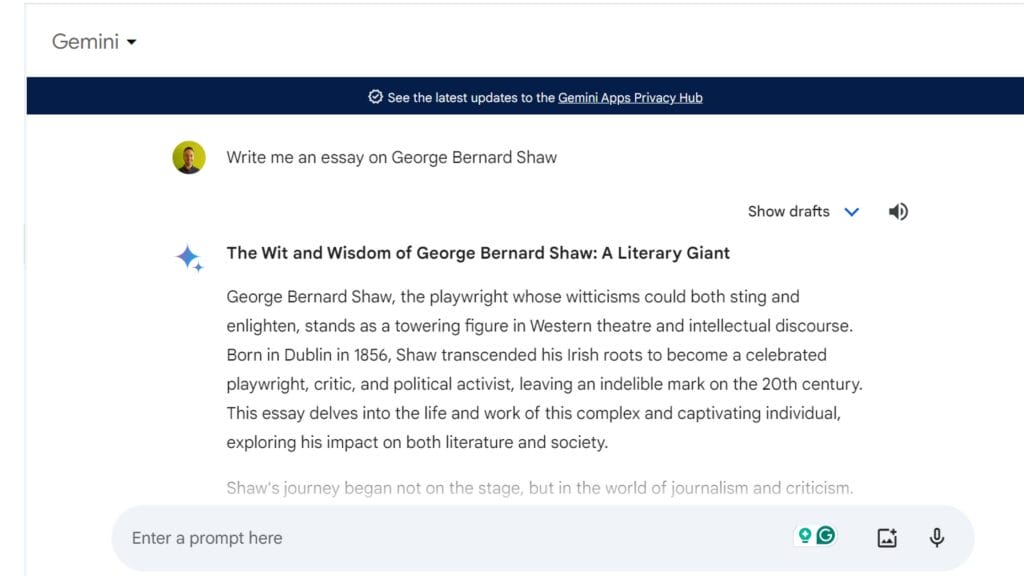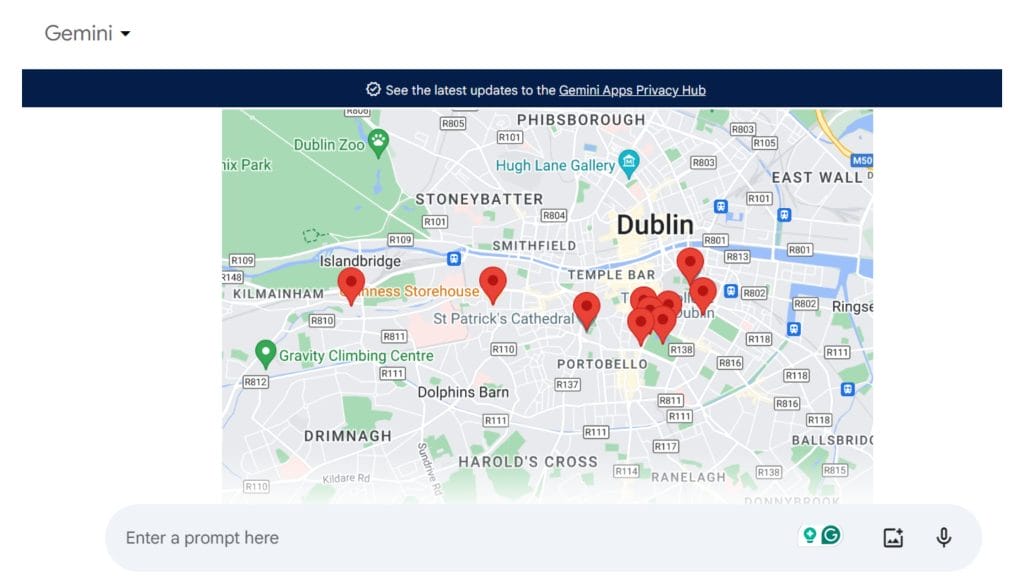AI detectors are capable of detecting written output from Google’s AI tool Gemini. You should always use an AI-detecting tool like Winston AI as part of your toolkit if you need to know if a text was written by AI or by a person.
What is Google Gemini?
Google Gemini is a generative AI chatbot that can perform many tasks like writing emails, blog posts and writing code.
Google Gemini is similar to ChatGPT and you can test it out here. Gemini is also the name of the large language model and the current model is Gemini 1.5 pro. There is also a more advanced model called Gemini Advanced Ultra which you need to pay for.
Google also plans to integrate Google Gemini into some of their other products like Google Docs and Gmail. This will lead to a whole host of applications that I am excited to try. This will only be available to people who sign up for Google Advanced.
Testing Google Gemini for AI Detection
Google Gemini can be detected as AI content from AI content detectors like Winston AI.
An AI checker is a tool that can detect if a text was written by a person or an AI tool.
AI detectors work by analysing language patterns and comparing text against a database text when we already know if the text was human-written or machine-generated.
Our AI detection tool has a 99.98% when detecting AI content.
Let’s test out Google Gemini by asking it to write an essay for us.

Now let’s copy this text into Winston AI and see the results.

As you can see, Winston AI correctly identified the text as 0% Human.
Google Gemini vs ChatGPT – What’s the Difference?
Google Gemini is quite similar to ChatGPT but there are some differences.
First of all, both chatbots can connect to the internet with Gemini using Google’s search engine and ChatGPT using Microsoft’s Bing.
One of the main advantages of Google Gemini over ChatGPT is that it has a large context window. AI chatbots need context to perform better and one of the limitations of ChatGPT is that you can’t give it a large amount of data(like a book or a long video) and ask it to give you information.
Gemini for example, when given the 402-page transcripts from Apollo 11’s mission to the moon, can reason about conversations, events and details found across the document.
ChatGPT on the other hand has some of its own benefits like the ability to create AI images and custom GPTs (you can make your own chatbot with your own data added to ChatGPT).
Google Gemini vs Google Bard
Google Gemini replaced Google Bard in February 2024. From early testing, Gemini has better output and is much less buggy. The user interface seems a little nicer too.
In reality, Google just rebranded Google Bard as Google Gemini. Large Language Models are constantly being updated.
So naturally Gemini is better at creating text and code but it also seems to integrate better with Google’s other products.
Look at this itinerary for Dublin that gave me all the places I can go on Google Maps

What is Google Gemini Advanced?
Both Google Gemini and Gemini Advanced are AI language models but with key differences. Gemini, powered by Pro 1.0, excels at text-based tasks like writing and questions. Think of it as your helpful, everyday language assistant.
Gemini Advanced uses the more powerful Ultra 1.0 model. It is better for complex tasks like coding and image processing. Think of it as your professional collaborator, unlocking advanced tools for specific needs. Gemini is free to use but Gemini Advanced requires a paid subscription.
Can you Bypass AI Dectors with Google Gemini?
While it is always possible to bypass an AI Detector and some AI detectors produce false positives it all depends on the AI detector that you are using.
Our AI detector Winston AI detects AI content with an accuracy rate of 99.98% and as you can see from above, we also detect Google’s Gemini. This happens as all AI tools follow patterns of text whereas humans tend to write a bit more randomly. People tend to repeat the same words in close proximity and then throw in a random phrase whereas machines tend to use the same language again and again(I have noticed they love discourse markers like “additionally”, “furthermore”, “however” and “overall”.
There are tools out there that try to “humanize text” by changing the syntax(the word order) of AI writing but in my opinion they just make writing harder to read. For now, we need people to write to people but there are certain situations where AI writing tools may be helpful.
Final Thoughts
Many students and writers are using AI tools like Google Gemini to do their work for them. It is important for academic integrity and accuracy online that we can distinguish AI written text from text that people write. For this reason, you should consider using an AI detection tool like Winston AI.
The term “large context window” refers to Google Gemini’s ability to understand and analyze large amounts of data at once. Unlike other AI models that might struggle with extensive datasets, Gemini can process and reason about vast documents or data sets—like the 402-page Apollo 11 mission transcripts—allowing it to provide more comprehensive responses based on a wider context.
Gemini 1.5 Pro and Gemini Advanced Ultra represent different versions of Google’s large language model, with each designed for distinct types of tasks. Gemini 1.5 Pro is suited for everyday tasks such as writing and basic queries, offering broad assistance for general users. In contrast, Gemini Advanced Ultra, which requires a subscription, is designed for more complex tasks like advanced coding and image processing, catering to professional or advanced users’ needs.
Integrating Google Gemini into Google Docs and Gmail means users can leverage Gemini’s AI capabilities directly within these applications. This could include automatic writing assistance, email drafting, content creation, and other AI-driven functionalities that enhance productivity and streamline workflows within Google’s ecosystem.
Google Bard was replaced by Google Gemini as part of Google’s ongoing development and improvement of their AI technologies. The transition to Gemini reflects both a rebranding effort and an upgrade in the AI model’s capabilities, offering users enhanced performance, fewer bugs, and a better overall user experience. This change underscores Google’s commitment to refining its AI products and providing users with the most advanced and efficient tools.
AI content detectors, such as Winston AI, analyze text to determine whether it was generated by a human or an AI. These tools examine language patterns, stylistic features, and other textual characteristics, comparing them against a database of known human and machine-generated texts. Their high accuracy rates, such as Winston AI’s 99.98%, are achieved through sophisticated algorithms capable of identifying subtle cues indicative of AI-generated content.



